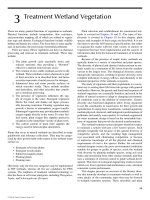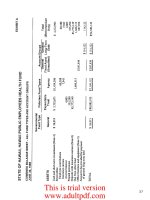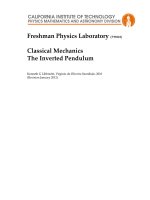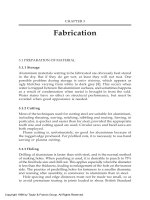- Trang chủ >>
- Khoa Học Tự Nhiên >>
- Vật lý
Chapter 3: The Inverted Pendulum potx
Bạn đang xem bản rút gọn của tài liệu. Xem và tải ngay bản đầy đủ của tài liệu tại đây (175.53 KB, 19 trang )
PHYSICS MATHEMATICS AND ASTRONOMY DIVISION
CALIFORNIA INSTITUTE OF TECHNOLOGY
Freshman Physics Laboratory (PH003)
Classical Mechanics
The Inverted Pendulum
Kenneth G Libbrecht, Virginio de Oliveira Sannibale, 2010
(Revision January 2012)
DRAFT
Chapter 3
The Inverted Pendulum
3.1 Introduc tion
The purpose of this lab is to e xplore the dynamics of the simple harmonic
oscillator (SHO). To make things a bit more interesting, we will model
and study the motion of an inverted pendulum (IP), which is a special
type of tunable mechanical oscillator. As we will see below, the inverted
pendulum contains two restoring forces, one positive and one negative.
By adjusting the relative strengths of these two forces, we can change the
oscillation frequency of the pendulum over a wide range.
As usual (see Chapter 1), we will first make a mathematical model of
the inverted pendulum. Then you will characterize the system by mea-
suring various parameters in the model. And finally you will observe the
motion of the pendulum and see that it agrees with the model (to within
experimental uncertainties).
The inverted pendulum is a fairly simple mechanical device, so you
should be able to analyze and characterize the system almost completely.
At the same time, the inverted pendulum exhibits some interesting dy-
namics, and it demonstrates several important principles in physics. Waves
and oscillators are everywhere in physics and engineering, and one of the
best ways to understand oscillatory phenomenon is to carefully analyze a
relatively simple system like the inverted pendulum.
27
DRAFT
28
CHAPTER 3. THE INVERTED PENDULUM
3.2 Modeling the Invert ed Pendulu m (IP)
3.2.1 The Simple Harmonic Oscillator
We begin our discussion with the most ba sic harmonic oscillator – a mass
on a spring. We can write the restoring force F = −kx in this case, where k
is the spring constant. Combining this with Newton’s law, F = ma = m
¨
x,
gives
¨
x = −(k/m)x, or
¨
x + ω
2
0
x = 0 (3.1)
with ω
2
0
= k/m
The general solution to this equation is x(t) = A
1
cos(ω
0
t) + A
2
sin(ω
0
t),
where A
1
and A
2
are constants. (You can plug x(t) in yourself to see that
it solves the equation.) Once we specify the initial conditions x(0 ) and
˙
x(0), we can then calculate the constants A
1
and A
2
. Alternatively, we can
write the general solution as x(t) = A cos(ω
0
t + ϕ), where A and ϕ are
constants.
The math is simpler if we use a complex function
˜
x(t) in the equation,
in which case the solution becomes
˜
x(t) =
˜
Ae
iω
0
t
, where now
˜
A is a com-
plex constant. (Again, see that this solves the equation.) To get the actual
motion of the oscillator, we then take the real part, so x(t) = Re[
˜
x(t)]. (If
you have not yet covered why this works in your other courses, see the
EndNote at the end of this chapter.)
You should be awa re that physicists and engineers have become quite
cavalier with this complex notation. We often write that the ha rmonic os-
cillator has the solution x(t) = Ae
iω
0
t
without specifying what is complex
and what is real. This is lazy shorthand, and it makes sense once you
become more familiar with the dynamics of simple harmonic motion.
The B ottom Line: Equation 3.1 gives the equation of motion for a sim-
ple harmonic oscillator. The easiest way to solve this equation is using the
the complex notation, giving the solution x(t) = Ae
iω
0
t
.
3.2.2 The Simple Pendulum
The next step in our analysis is to look at a simple pendulum. Assume
a mass m at the end of a massless string of a string of length ℓ. Gravity
exerts a force mg downward on the mass. We can write this force as the
DRAFT
3.2. MODELING THE INVERTED PENDULUM (IP)
29
Leg
Flex Joint
l
Mass
θ
M
θ
Mg
kl
θ
Mg
Figure 3.1: Simple Inverted Pendulum.
vector sum of two forces: a force mg cos θ parallel to the string and a force
mg sin θ perpendicular to the string, where θ is the pendulum angle. (You
should draw a picture and see for yourself that this is correct.) The force
along the string is exactly countered by the tension in the string, while the
perpendicular force gives us the equation of motion
F
perp
= −mg sin θ (3.2)
= mℓ
¨
θ
so
¨
θ +
(
g/ℓ
)
sin θ = 0
As it stands, this equation has no simple analytic solution. However we
can use sin θ ≈ θ for small θ, which gives the harmonic oscillator equation
¨
θ + ω
2
0
θ = 0 (3.3)
where ω
2
0
= g/ℓ (3.4)
The Bottom Line: A pendulum exhibits simple harmonic motion de-
scribed by Equation 3.3, but only in the limit of small angles.
DRAFT
30
CHAPTER 3. THE INVERTED PENDULUM
3.2.3 The Simple Inverted Pendulum
Our model for the inverted pendulum is shown in Figure 3.1. Assuming
for the moment that the pendulum leg has zero mass, then gravity exerts
a force
F
perp
= +Mg sin θ (3.5)
≈ Mgθ
where F
perp
is the component of the gravitational force perpendicular to
the leg, and M is the mass at the end of the leg. The force is positive,
so gravity tends to make the inverted pendulum tip over, as you would
expect.
In addition to gravity, we also have a fle x joint at the bottom of the leg
that is essentially a spring that tries to keep the pendulum upright. The
force from this spring is given by Hooke’s law, which we can write
F
spring
= −kx (3.6)
= −kℓθ
where ℓ is the length of the leg.
The equation of motion for the mass M is then
M
¨
x = F
perp
+ F
spring
(3.7)
Mℓ
¨
θ = Mgθ − kℓθ
and rearranging gives
¨
θ + ω
2
0
θ = 0 (3.8)
where ω
2
0
=
k
M
−
g
ℓ
(3.9)
If ω
2
0
is positive, then the inverted pe n d ulum exhibits simple harmonic
motion θ(t) = Ae
iω
0
t
. If ω
2
0
is negative (for example, if the spring is too
weak, or the top mass is to great), then the pendulum simply falls over.
The Bottom Line: A simple inverted pendulum (IP) exhibits simple
harmonic motion described by Equation 3.8. The restoring force is sup-
plied by a spring at the bottom of the IP, and there is also a negative restor-
ing force from gravity. The resonant frequency can be tuned by changing
the mass M on top of the pendulum.
DRAFT
3.2. MODELING THE INVERTED PENDULUM (IP)
31
3.2.4 A Better Model of the Inverted Pendulum
The simple model above is unfortunately not good enough to describe the
real inverted pendulum in the lab. We need to include a nonzero mass
m for the leg. In this case it is best to start with Newton’s law in angular
coordinates
I
t ot
¨
θ = τ
t ot
(3.10)
where I is the total m oment of inertia of the pendulum about the pivot
point and τ is the sum of all the relevant torques. The moment of inertia
of the large mass is I
M
= Mℓ
2
, while the moment of inertia of a thin rod
pivoting about one end (you can look it up, or calculate it) is I
leg
= mℓ
2
/3.
Thus
I
t ot
= Mℓ
2
+
mℓ
2
3
(3.11)
=
M +
m
3
ℓ
2
The torque consists of three components
τ
t ot
= τ
M
+ τ
leg
+ τ
spring
(3.12)
= Mgℓ sin θ + mg
ℓ
2
sin θ −kℓ
2
θ
The first term comes from the usual expression for torque τ = r ×F, where
F is the gravitational force on the mass M, and r is the distance between
the mass and the pivot point. The second term is similar, using r = ℓ/2
for the center-of-mass of the leg. The last term derives from F
spring
= − kℓθ
above, converted to give a torque about the pivot point.
Using sin θ ≈ θ, this becomes
τ
t ot
≈ Mgℓθ + mg
ℓ
2
θ −kℓ
2
θ (3.13)
≈
Mg ℓ +
mgℓ
2
− kℓ
2
θ
and the equation of motion becomes
I
t ot
¨
θ = τ
t ot
(3.14)
M +
m
3
ℓ
2
¨
θ =
Mg ℓ +
mgℓ
2
− kℓ
2
θ (3.15)
DRAFT
32
CHAPTER 3. THE INVERTED PENDULUM
which is a simple harmonic oscillator with
ω
2
0
=
kℓ
2
− Mgℓ −
mgℓ
2
M +
m
3
ℓ
2
(3.16)
This expression gives us an oscillation frequency that better describes
our real inverted pendulum. If we let m = 0, you can see that this becomes
ω
2
0
(m = 0) =
k
M
−
g
ℓ
(3.17)
which is the frequency of the simple inverted pendulum described in the
previous section. If we remove the top mass entirely, so that M = 0, you
can verify that
ω
2
0
(M = 0) =
3k
m
−
3g
2ℓ
(3.18)
The Bottom Line: The math gets a bit more complicated when the leg
mass m is not negligible. The resonance frequency of the IP is then given
by Equation 3.16. This reduces to Equation 3.17 when m = 0, and to Equa-
tion 3.18 when M = 0.
3.3 The Damped Harmoni c Oscillator
To describe our real pendulum in the lab, we will ha ve to include damping
in the equation of motion. One way to do this (there are others) is to use a
complex spring constant given by
˜
k = k(1 + iφ) (3.19)
where k is the normal (real) spring constant and φ (also real) is called the
loss angle. Looking at a simple harmonic oscillator, the equation of motion
becomes
m
¨
x = −k(1 + iφ)x (3.20)
which we can write
¨
x + ω
2
dampe d
x = 0 (3.21)
with ω
2
dampe d
=
k(1 + iφ)
m
(3.22)
DRAFT
3.4. THE DRIVEN HARMONIC OSCILLATOR
33
If the loss angle is small, φ ≪ 1, we can do a Taylor expansion to get the
approximation
ω
dampe d
=
k
m
(1 + iφ)
1/2
(3.23)
≈
k
m
(1 + i
φ
2
) (3.24)
= ω
0
+ iα (3.25)
with α =
φω
0
2
(3.26)
Putting all this together, the motion of a weakly damped harmonic os-
cillator becomes
˜
x(t) =
˜
Ae
−αt
e
iω
o
t
(3.27)
which here
˜
A is a complex constant. If we take the real part, this becomes
x(t) = Ae
−αt
cos(ω
0
t + ϕ) (3.28)
This is the normal harmonic oscillator solution, but now we have the extra
e
−αt
term that describes the exponential decay of the motion.
We often refer to the quality factor Q of an oscillator, which is defined as
Q = ω
Energy stored
Power loss
(3.29)
Note that Q is a dimensionless number. For our case this becomes (the
derivation is left for the reader)
Q ≈
ω
0
2α
=
1
φ
(3.30)
The Bottom Line: We can model damping in a harmonic oscillator by
introducing a complex spring constant. Solving the equation of motion
then gives damped oscillations, given by Equations 3. 27 and 3.28 when
the damping is weak.
3.4 The Dr iven Harmonic Oscillator
If we drive a simple harmonic oscillator with an external oscillatory force,
then the equation of motion becomes
¨
x + ω
2
dampe d
x = Be
iωt
(3.31)
DRAFT
34
CHAPTER 3. THE INVERTED PENDULUM
where ω is the angular frequency of the drive force and B is a complex
constant. (As a bove, ω
dampe d
= ω
0
+ iα.) Analyzing this shows that the
system first exhibits a transient behavior that lasts a time of order
t
transient
≈ α
−1
≈ 2Q/ω
0
(3.32)
During this time the motion is quite complicated, depending on the initial
conditions and the phase of the applied force.
The transient behavior eventually dies away, however, and for t ≫
t
transient
the system settles into a steady-state behavior, where the motion is
given by
x(t) = Ae
iωt
(3.33)
In other words, in steady-state the system oscillates with the same fre-
quency as the applied force, regardless of the natural frequency ω
0
. Plug-
ging this x(t) into the equation of motion quickly gives us
A =
B
ω
2
dampe d
−ω
2
(3.34)
Since A is a complex constant, it gives the amplitude and phase of the
motion. When the damping is small (α ≪ ω
0
), we can write ω
2
dampe d
≈
ω
2
0
+ 2iαω
0
, giving
A ≈
B
ω
2
0
−ω
2
+ 2iαω
0
(3.35)
and the amplitude of the driven oscillations becomes
|
A
|
=
|
B
|
ω
2
0
− ω
2
2
+ 4α
2
ω
2
0
(3.36)
Note that the driven oscillations have the highest amplitude on resonance
(ω = ω
0
), and the peak amplitude is highest when the damping is lowest.
The Bottom Line: Once the transient motions have died awa y, a har-
monically driven oscillator settles into a steady-state motion exhibiting
oscillation at the same frequency as the drive. The amplitude is highest
on resonance (when ω = ω
0
) and when the damping is weak, as given by
Equation 3.36.
DRAFT
3.5. THE TRANSFER FUNCTION
35
3.5 The Transfer Function
For part of this la b you will shake the base of the inverted pendulum and
observe the response. To examine this theoretically, we can look first at
the simpler case of a normal pendulum in the small-angle approximation
(when doing theory, always start with the simplest case and work up). The
force on the pendulum bob (see Equation 3.2) can be written
F = −mgx/ℓ (3.37)
where x is the horizontal position of the pendulum and ℓ is the length.
If we shake the top support of the pendulum with a sinusoidal motion,
x
t op
= X
drive
e
iωt
, then this becomes
F = −mg
x −x
t op
/ℓ (3.38)
¨
x + ω
2
0
x = ω
2
0
x
t op
(3.39)
where ω
2
0
= g/ℓ. With damping this becomes
¨
x + ω
2
dampe d
x = ω
2
0
x
t op
(3.40)
= ω
2
0
X
drive
e
iωt
(3.41)
which is essentially the same as Equation 3.31 for a driven harmonic oscil-
lator. From the discussion above, we know that this equation has a steady-
state solution with x = Xe
iωt
. It is customary to define the transfer function
H(ω) =
X
X
drive
(3.42)
which in this case is the ratio of the motion of the pendulum bob to the
motion of the top support. Since H is complex, it gives the ratio of the
amplitudes of the motions and their relative phase.
For the simple pendulum case, Eq uation 3.35 gives us (verify this for
yourself)
H(ω) ≈
ω
2
0
ω
2
0
−ω
2
+ 2iαω
0
(3.43)
At low frequencies (ω ≪ ω
0
) and small damping (α ≪ ω
0
), this becomes
H ≈ 1, as you would expect (to see this, consider a mass on a string,
DRAFT
36
CHAPTER 3. THE INVERTED PENDULUM
and shake the string as you hold it in your hand). At high frequencies
(ω ≫ ω
0
), this becomes H(ω) ≈ −ω
2
0
/ω
2
, so the motion of the bob is 180
degrees out of phase with the motion of the top support (try it).
The Bottom Line: The transfer function gives the complex ratio of two
motions, and it is often used to characterize the behavior of a driven os-
cillator. Equation 3.43 shows one example for a simple pe ndulum. The
motion of the inverted pendulum is a bit more interesting, as you will see
when you measure H(ω) in the lab.
3.6 The Inverte d Pendulum Test Bench
3.6.1 Care and Use of the Apparatus
The I nverted Pendulum hardware is not indestructible, so please treat it
with re spect. Ask your TA if you think something is broken or otherwise
amiss. The flex joint is particularly delicate, and bending it to large angles
can cause irreparable damage. Follow these precautions:
1. Never let the IP oscillate without the travel limiter.
2. Do not let the IP leg fall.
3. Do not disassemble the IP without assistance from your TA.
3.7 The Lab - First Week
3.7.1 Pre-Lab Problems
1. Rewrite Equation 3.16 using the “angular stiffness” variable κ = kℓ
2
for
the spring constant. What are the units of k, κ?
2. Determine the length of an IP leg with a load of M = 0. 300 kg, flex
joint angular stiffness κ = 10 Nm, oscillation period T = 10 seconds, and
negligible leg mass, m = 0. Compute the length of a simple pe ndulum
with the same oscillation frequency.
3. For the IP in Problem 2, calculate the mass difference ∆M needed to
change the period from 10 seconds to 100 seconds. At what mass does the
period go to infinity?
4. For the IP in Problem 2, if the loss angle is φ = 10
−2
, how long does
it take for the motion to damp to 1% of its starting amplitude?
DRAFT
3.7. THE LAB - FIRST WEEK
37
Velocity
Sensor
Velocity
Sensor
Shaker
Table
Damper
Plate
Leveling
Screw
Actuator Platform
Leg
Actuator
Shim Stock
Disks
Flex Joint
Base
Travel Limiter
Connector
Coil
Permanent Magnet
Figure 3.2: Inverted pendulum test bench .
3.7.2 In-Lab Exercises
3.7.2.1 Getting Started
Please read down to the end of this section before beginning your work.
Once you begin in the lab, record all your data and other notes in your
notebook as you proceed. Print out relevant graphs and tape them into
your notebook as well.
Step 1. All the measurements this week are done with the actuator pla t-
form locked in place. U se the attached thumb screws to lock the platform
(see your TA if you are not sure about this). If the platform is securely
DRAFT
38
CHAPTER 3. THE INVERTED PENDULUM
locked, it should not rattle if you shake it gently.
Load device
l
Arrow shaftFlex joint
Figure 3.3: IP leg with the flex joint and the load device.
3.7.2.2 The IP Leg
When adding mass to the top of the leg, add weights symmetrically on
the load device (see Figure 3.3). This ensures that the center-of-mass of
the a d ded weight is always positioned at the same distance from the pivot
point (i.e., this ensures that ℓ stays constant as you change M).
Step 2. Using the spare leg in the lab, me a sure the length ℓ and mass
m of the leg, including measurement uncertainties (error bars). Measure ℓ
from the center of the flex joint to the center-of-mass of the adde d weight.
Note that you cannot actually me asure ℓ very well because of the large
size of the flex joint. Use common sense to estimate an uncertainty in ℓ,
based on the length of the flex joint and how accurately the load mass can
be placed . Note that your measurement of m does not include the mass
of the magnet assembly on the IP, which you can take to be M
magent
= 6
grams.
3.7.2.3 Resonant Frequency versus Load
Step 3. With no mass on the top of the leg (M
add
= 0), measure the oscilla-
tion frequency P = 1/2πω
1
(with an error bar) of the IP using the Matlab
data-acquisition function IPRingDown. Use Equation 3.16 to estimate k
based on your frequency measurement. Use your direct measurements of
m and ℓ. Assuming that the theory in Equation 3.16 is exact, use standard
DRAFT
3.7. THE LAB - FIRST WEEK
39
error propagation methods to estimate an error bar for k from the errors in
the other quantities.
Step 4. Make additional measurements of P for different values of
M
add
. U se the load device with no washers, then add washers symmet-
rically about the center-of-mass (see Figure 3.3). For each measurement
of P , also measure M
add
using the scale in the lab. Take at least 5-6 data
points with error bars. Note that the errors in the measurement of P are
larger for larger P. Make a plot of P(M
add
) using the Matlab plotting func-
tion PlotBoxesLinLin (plotting with 2d error bars). Add the plot to your
notebook.
Note that you may have to level the IP as you add more mass (using
the three leveling screws; ask your TA if you need help). As the top mass
increases, the IP is more likely to tip over, so the leveling of the apparatus
is more important.
Step 5. Now use Equation 3.16 to create a theory line to add to your
data plot. One way to accomplish this is by creating a short Matlab pro-
gram (a *. m file). Here is an example (ask your TA if you need help writing
your own program in Matlab):
% ip1.m - sample program to plot IP data with theory
clear; close;
%data arrays
% added mass placed on top of IP, in kg
mass = [M1 M2 M3 M4 M5 M6]; %note M1=0
% measured IP periods, in seconds
period = [P0 P1 P2 P3 P4 P5 P6];
%guess for mass of magnet assembly
k = input(’Enter guess for k: ’);
semilogy(mass,per iod,’o’) %plots data points on semilog scale
axis([-0.03 0.35 0.25 10]) %[xmin xmax ymin ymax] adjust for a nice plot
xlabel(’Added mass, kg’)
ylabel(’IP period, second s’)
hold on
%keeps plot open so can add theory line below
% constants for theory
g = 9.796; %gravitational constant
m = 0.0xx; %measured shaft mass in kg
ell = 0.xx; %measured shaft length in meters
Madd = 0:0.001:0.35; %added mass vector for theory line
%total M in Eqn 15 = added mass + extra mass from magnet (6 grams)
M = Madd + 0.006;
DRAFT
40
CHAPTER 3. THE INVERTED PENDULUM
num = k*(ell^2) - M.*g*ell - m*g*ell/2; %numerator in equation
%note .* or ./ for multiplying or dividing an array by a constant
den = (M + m/3).*(ell^2); %denominator in equation
om1a = sqrt(num./den); %omega calculated
percalc = 2*pi./om1a; %oscillation period, to compare with data
plot(Madd,percalc) %adds theory line to graph; note plots versus added mass M
add
,
same as the data plot
%end of program ip1
Try putting in different values of k to see how the theory changes. You
should get a nice fit using your calculated value of k, although a different
value may fit better. The real IP is not exactly the same as depicted in
theory, so there will be some systematic discrepancies. Your data may also
deviate significantly from theory as the calculated period goes to infinity
(because the real IP is not perfect). Plot the data with theory for your best
guess for k, and add the plot to your notebook.
Step 6. From observing how well the theory fits the data for different
guesses for k, estimate your best-fit k along with an error bar (hint: use a
difference plot). How does this compare with your estimate of k in Step 3?
3.8 The Lab - Second We ek
3.8.1 Pre-Lab Problems
1. Plot the amplitude response of a driven harmonic oscillator, given by
Equation 3.36. Assume a resonance frequency ν
0
= 1 Hz, B = 1, and
plot the amplitude as a function of frequency ν = ω/2π. Make three plots
(preferably all on a single graph) using Q = 1, 10 , 100. Plot all three on a
linear-linear plot, then plot all three again on a log-log plot. Note that the
response shows a power-law behavior (x ∼ ν
−2
) at high frequencies, and
this appears as a straight line in the log-log plots.
2. Let ∆ν be the FWHM (full-width at half-maximum) width of
|
A(ν)
|
(i.e. when ν = ν
0
± ∆ν/2, then
|
A
(
ν
)|
=
|
A
(
ν
0
)|
/2). In the limit of high
Q, what is ∆ν as a function of Q? (Use Equation 3.36 and let ω = ω
0
+ ε,
so near the peak you can take ω
2
≈ ω
2
0
+ 2αε. )
3. In the lab we will measure
˙
X(ν) and
˙
X
drive
(ν), the velocities of the
pendulum bob and support platform. Show that H(ν) = X(ν)/X
drive
(ν) =
˙
X(ν)/
˙
X
drive
(ν).
DRAFT
3.8. THE LAB - SECOND WEEK
41
3.8.2 In-Lab Exercises
3.8.2.1 Inverted Pendulum Loss Angle
Step 1. With the actuator platform locked (same as last week), use IPRing-
Down to observe the motion of the inverted pendulum with no added
mass and no added damping. Put a plot of the IP motion x
IP
(t) in your
notebook, and estimate the loss angle φ from the time it takes the motion
to damp awa y. Now add the aluminum damper plate to the top of the IP
assembly (ask your TA). As the pendulum swings, the damping ma gnet
induces a current in the aluminum plate, which heats the plate and ex-
tracts energy from the I P motion. With the aluminum plate in place (about
6 mm from the magnet), again plot x
IP
(t) and estimate φ from a fit. Un-
screw the magnet holder tube a bit so the magnet is quite close to the plate,
and again plot x
IP
(t) and estimate φ. For each case, how long is t
transient
– the time needed for a driven system to reach steady-state motion (see
Equation 3.32)?
3.8.2.2 The Transfer Function
The rest of the lab is done with the actuator platform unlocked; ask your
TA if you need help with this. Drive the motion of the p latform using a
sinusoidal voltage from the signal generator. Be sure to set the "sweep"
button to EXT (which turns off the sweep feature of the signal generator).
With a high signal amplitude you should be able to see the platform oscil-
lating, and you can see the frequency change as you change the frequency
of the drive voltage. MAKE SURE THAT THE MOTION OF THE PLATFORM IS
SINUSOIDAL.
With no added mass on the IP, use the Matlab program IPTransmissibility
to mea sure the motion of the p latform x
plat form
(t) and the motion of the
top mass x
IP
(t). Use the ’t’ command to view both motions as a function
of time. If both do not show simple sinusoidal oscillations, turn down the
drive amplitude. The program IPTransmissibility will collect data for you as
you change the drive frequency, and it will compare x
IP
(t) and x
plat form
(t)
to give you the amplitude and phase of the transfer function as a function
of frequency.
Step 2. Collect data at a sufficient number of drive frequencies to map
out the transfer function H(ν) as a function of frequency. Put a plot of
H(ν) in your notebook, and qualitatively explain the features of H(ν)
DRAFT
42
CHAPTER 3. THE INVERTED PENDULUM
(both amplitude and pha se ), given the above discussion of a driven har-
monic oscillator.
Step 3. Now add mass to the IP so the resonant frequency is between
0.5 and 1 Hz (use your data from last week to see what M is needed). Place
the damper plate about 3 mm from the damping magnet. Starting at low
frequencies, use IPTransmissibility to again map out H(ν). Again, use the
’t’ command to make sure the motions are sinusoidal. Above the reso-
nance frequency of the IP, you will need to turn up the drive amplitude
so the signal-to-noise in the measurements remains adequate. Be sure to
continue your measurements to at least 10 Hz. Put a plot of H(ν) in your
notebook, and again qualitatively explain the features of H(ν) (both a m-
plitude and phase). [Hint: an understanding of the "center of percussion"
of a bar will be useful for explaining the high-frequency behavior.]
3.9 EndNote: Using Complex Functi ons to Solve
Real Equations
Physicists and engineers often use complex functions to solve real equa-
tions, with the und erstanding that you take the real part at the end. Why
does this work? And why do we even do this? We can demonstrate
with the simple harmonic oscillator. Start with the equation of motion
¨
x + ω
2
0
x = 0, and let us solve this using a complex function: x = α + iβ,
where α(t) and β(t) are real functions. If you plug this in, you will see that
¨
x + ω
2
0
x = 0 becomes
¨
α + i
¨
β
+ ω
2
0
(
α + iβ
)
= 0 (3.44)
¨
α + ω
2
0
α
+ i
¨
β + ω
2
0
β
= 0
Since a complex number equals zero only if both the real and imaginary
parts equal zero, we see that
¨
x + ω
2
0
x = 0 implies that both
¨
α + ω
2
0
α = 0
and
¨
β + ω
2
0
β = 0. In other words, both the real and imaginary parts of x(t)
satisfy the original equation.
So we have a procedure: try using a complex function to solve the
original equa tion. If this works, then taking the real part of the solution
gives a real function that also solves the same differential equation. (If in
doubt, then verify directly that the real part solves the equation.)
DRAFT
3.9. ENDN OTE: USIN G COMPLEX FUNCTIONS TO SOLVE REAL EQUATIONS
43
Why do we go to the trouble of using complex functions to solve a real
equation? Because differential equations are often easier to solve when
we assume complex functions (seems counterintuitive, but it’s true). The
function e
iω
0
t
is a simple exponential, and the derivative of an exponential
is another exponential – that makes things simple. In contrast, cosines and
sines are more difficult to work with.
In the case of the simple harmonic oscillator, the solution x(t) = Ae
iωt
has a natural interpretation. The length and angle of the A vector (in the
complex plane) give the amplitude and phase of the oscillations.
You should note, however, that this only works for linear equations. If
our eq ua tion were
¨
x + ω
2
0
x + γx
2
= 0, for example, then using complex
functions would not have the same benefits. In fact there is no simple so-
lution to this equation, complex or otherwise. This equation de scribes a
nonlinear oscillator, and nonlinear oscillators exhibit a fascinating dynam-
ics with interesting behaviors that people still study to this day.
DRAFT
44
CHAPTER 3. THE INVERTED PENDULUM









